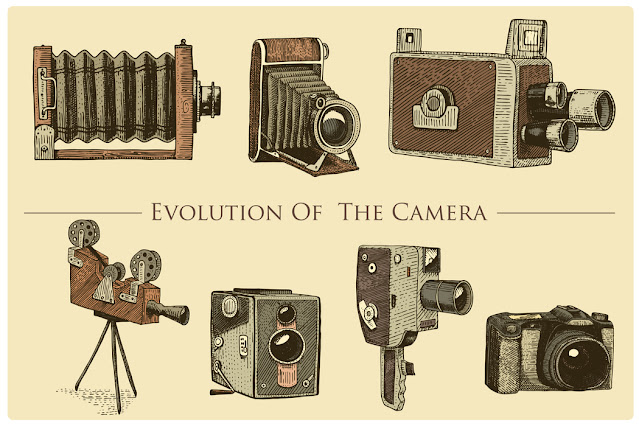Photography and Evolution of the Camera
The camera is everywhere today, but it was not easy a few years ago before coming smartphone camera. Before this camera came in the pocket phone, the camera had to travel a long way.
Pictures are taken with different lights. As long as this light could not be stored by any means, pictures were drawn by rubbing a pencil on paper. The camera is a means of storing light.
Well, will we see empty light, or will we see something else with light? If we see light in light, then nothing can be saved. The idea of looking at this light in a different way was the first to create the ‘Camera Obscura’, which is a precursor to pinhole cameras. The camera obscura is a closed dark chamber, where light enters through a narrow hole and reflects light on the opposite wall. The Arab scholar Abu Ali-al-Asan ibn al-Asan ibn al-Haytham (975-1040 AD) mentions this reflection of light in his book Book of Optics (Kitab al-Manazir), written between 1012 and 1021 AD. He uses the word ‘al-Bayt al-Muthalim’ in his book, which means ‘dark room’. To test it, he darkened a room and saw a solar eclipse through a narrow hole in the window. But the reflection of the eclipse was the opposite. With that, it was an ongoing reflection.
Camera History: Camera Lucida and its drawing method
Camera obscura was later used by scientists to observe solar eclipses. At the same time, it became popular among painters, which came to be known as ‘Camera Lucida’. The Camera Lucida is equipped with a prism that allows the painter to draw more accurately.
Thus the concept of photography was invented. There are various experiments in light of the change in time. Later, in the early nineteenth century, Joseph Nipsey was able to save light through various experiments. The picture, known as the first preserved picture, was of another window from the window of his home. Due to the continuous eight-hour exposure and the changing position of the sun, both sides of the building can be seen.
The first picture saved by Nipsey
Luis Daguerre, on the other hand, spends his time trying to save pictures. His efforts led him to work with Nippes in 1829. They do various tests. Still failed to save the picture permanently at once. After his death in 1835, Diego continued to work alone. He brought the eight-hour exposure to 30 minutes through various means, and in 1836 succeeded in making the picture completely permanent. The details of that photo were incomparable. He later signed a contract with Daguerre Nips' son and named the camera 'Daguero Type Camera'. Daguerre, the son of Nippes, sold the Daguero typewriter to the French government in 1839. Later on August 19 of that year, the French government opened the practice of photography to the whole world. Therefore, August 19 is celebrated as World Photography Day.
Daguerreotype camera
The image of the Daguerreotype camera is very clear, but there was a big problem that a picture could be printed from a negative. Which was the weight plate negative. This problem was encountered by William Henry Fox Talbert during his research. So he resumed his research and tried to take pictures on paper. He succeeded in making light-sensitive paper. He named his camera 'Calotype Camera'. Many pictures could be printed from the paper negative of the calotype camera. But there was a problem here too. The picture on the calotype camera was not very clear.
Calotype camera
Simultaneously the practice of photography began all over the world. Interestingly, the practice of photography in India began within a year of its introduction of photography. With that comes work on the Daguerreotype camera. From the weight plate negative to the weight plate glass negative was invented in 1850, which was able to print many times from the clear negative taken by the Daguerreotype camera.
In addition to still and portrait photography, various movements are added. To capture this movement, Edward Muybridge took 12 to 24 cameras side by side and released the shutters together. His work is based on the ‘chronographic song’. With this camera, it was possible to take 12 pictures at a time.
Chronographic songs
For so many days, some people started practicing photography as a hobby and others as a profession. In the early twentieth century, Kodak Brownie began selling cameras as a business venture. From the big box camera, the camera then gets smaller and moves between the two hands. As the size of the camera gets smaller, so does the size of the film. The journey of snapshots in photography begins.
Kodak Brownie Camera
Gradually the shape of the camera changes. From the box, the camera is the SLR camera. Digital sensors are added to the camera from analog film. Again, the sensor is added to the mobile phone to be small. The first camera phone was invented in 2000.
SLR and digital SLR cameras
Nowadays the camera is our daily companion. We all have different types of cameras, which help us to hold different memories. If we want, we can take pictures and keep them for ourselves, then we can print and arrange them again. These cameras are involved in a big part of our lives.









No comments:
Post a Comment
Thanks for your valuable comments and keeping touch sharing our posts from my PHOTO COLLECTION.